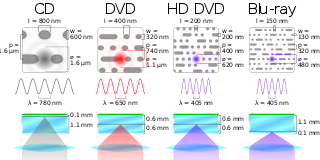Related Research Articles

An optical disc is a flat, usually disc-shaped object that stores information in the form of physical variations on its surface that can be read with the aid of a beam of light. Optical discs can be reflective, where the light source and detector are on the same side of the disc, or transmissive, where light shines through the disc to be detected on the other side.

In computing, an optical disc drive is a disc drive that uses laser light or electromagnetic waves within or near the visible light spectrum as part of the process of reading or writing data to or from optical discs. Some drives can only read from certain discs, but recent drives can both read and record, also called burners or writers. Compact discs, DVDs, and Blu-ray discs are common types of optical media which can be read and recorded by such drives.
A DVD recorder is an optical disc recorder that uses optical disc recording technologies to digitally record analog or digital signals onto blank writable DVD media. Such devices are available as either installable drives for computers or as standalone components for use in television studios or home theater systems.

The Blu-ray Disc Association (BDA) is the industry consortium that develops and licenses Blu-ray Disc technology and is responsible for establishing format standards and promoting business opportunities for Blu-ray Disc. The BDA is divided into three levels of membership: the board of directors, contributors, and general members.

Professional Disc (PFD) is a digital recording optical disc format introduced by Sony in 2003 primarily for XDCAM, its tapeless camcorder system. It was one of the first optical formats to utilize a blue laser, which allowed for a higher density of data to be stored on optical media compared to infrared laser technology used in the CD and red laser technology used in the DVD format.
In computing, external storage refers to non-volatile (secondary) data storage outside a computer's own internal hardware, and thus can be readily disconnected and accessed elsewhere. Such storage devices may refer to removable media, compact flash drives, portable storage devices, or network-attached storage. Web-based cloud storage is the latest technology for external storage.
Dolby TrueHD is a lossless, multi-channel audio codec developed by Dolby Laboratories for home video, used principally in Blu-ray Disc and compatible hardware. Dolby TrueHD, along with Dolby Digital Plus (E-AC-3) and Dolby AC-4, is one of the intended successors to the Dolby Digital (AC-3) lossy surround format. Dolby TrueHD competes with DTS's DTS-HD Master Audio, another lossless surround sound codec.
AVCHD is a file-based format for the digital recording and playback of high-definition video. It is H.264 and Dolby AC-3 packaged into the MPEG transport stream, with a set of constraints designed around the camcorders.
The first attempt at producing pre-recorded HDTV media was a scarce Japanese analog MUSE-encoded laser disc which is no longer produced.
Blu-ray Disc Recordable (BD-R) and Blu-ray Disc Recordable Erasable (BD-RE) refer to two direct to disc optical disc recording technologies that can be recorded on to a Blu-ray-based optical disc with an optical disc recorder. BD-R discs can only be written to once, whereas BD-RE discs can be erased and re-recorded multiple times, similar to CD-R and CD-RW for a compact disc (CD). Disc capacities are 25 GB for single-layer discs, 50 GB for double-layer discs, 100 GB ("XL") for triple-layer, and 128 GB for quadruple-layer.

This article compares the technical specifications of multiple high-definition formats, including HD DVD and Blu-ray Disc; two mutually incompatible, high-definition optical disc formats that, beginning in 2006, attempted to improve upon and eventually replace the DVD standard. The two formats remained in a format war until February 19, 2008, when Toshiba, HD DVD's creator, announced plans to cease development, manufacturing and marketing of HD DVD players and recorders.

Blu-ray is a digital optical disc data storage format designed to supersede the DVD format. It was invented and developed in 2005 and released worldwide on June 20, 2006, capable of storing several hours of high-definition video. The main application of Blu-ray is as a medium for video material such as feature films and for the physical distribution of video games for the PlayStation 3, PlayStation 4, PlayStation 5, Xbox One, and Xbox Series X. The name refers to the blue laser used to read the disc, which allows information to be stored at a greater density than is possible with the longer-wavelength red laser used for DVDs.

HD DVD is an obsolete high-density optical disc format for storing data and playback of high-definition video. Supported principally by Toshiba, HD DVD was envisioned to be the successor to the standard DVD format, but lost to Blu-ray, supported by Sony and others.

The PlayStation 3 technical specifications describe the various components of the PlayStation 3 (PS3) video game console.
In the history of optical storage media there have been and there are different optical disc formats with different data writing/reading speeds.
.m2ts is a filename extension used for the Blu-ray disc Audio-Video (BDAV) MPEG-2 Transport Stream (M2TS) container file format. It is used for multiplexing audio, video and other streams, such as subtitles. It is based on the MPEG-2 transport stream container. This container format is commonly used for high definition video on Blu-ray Disc and AVCHD.

DVD-Video is a consumer video format used to store digital video on DVDs. DVD-Video was the dominant consumer home video format in Asia, North America, Europe, and Australia in the 2000s until it was supplanted by the high-definition Blu-ray Disc. Discs using the DVD-Video specification require a DVD drive and an MPEG-2 decoder. Commercial DVD movies are encoded using a combination of MPEG-2 compressed video and audio of varying formats. Typically, the data rate for DVD movies ranges from 3 to 9.5 Mbit/s, and the bit rate is usually adaptive. DVD-Video was first available in Japan on November 1, 1996, followed by a release on March 26, 1997 in the United States—to line up with the 69th Academy Awards that same day.
AVCREC is a format for recording and playback of high definition video in BDAV format using conventional DVD recordable discs as recording media. Presently, AVCREC is tightly integrated with ISDB broadcast standard and is not marketed outside Japan.

M-DISC is a write-once optical disc technology introduced in 2009 by Millenniata, Inc. and available as DVD and Blu-ray discs.

Ultra HD Blu-ray is a digital optical disc data storage format that is an enhanced variant of Blu-ray. Ultra HD Blu-ray discs are incompatible with existing standard Blu-ray players. Ultra HD Blu-ray supports 4K UHD video at frame rates up to 60 progressive frames per second, encoded using High-Efficiency Video Coding. The discs support both high dynamic range by increasing the color depth to 10-bit per color and a greater color gamut than supported by conventional Blu-ray video by using the Rec. 2020 color space. Ultra HD Blu-Ray discs also support a 12-bit per color container via Dolby Vision. Dolby Vision content on 4K UHD Blu-Ray can also be mastered for 10,000 nits peak brightness, whereas standard HDR10 can only achieve a maximum of 4,000 nits of brightness. Moreover, Dolby Vision makes use of dynamic metadata, which adjusts the brightness and tone mapping per scene. In contrast, standard HDR10 only makes use of static metadata, which sets the same brightness and tone mapping for the entirety of the content.
References
- 1 2 3 Elliott, Matt. "Pioneer BDR-101A review: Pioneer BDR-101A". CNET. Retrieved 2023-07-05.
- 1 2 "BDR-101A - Blu-ray Disc writer for desktop computer – 25 Gbytes storage capacity". Pioneer Electronics USA. Retrieved 2023-07-05.